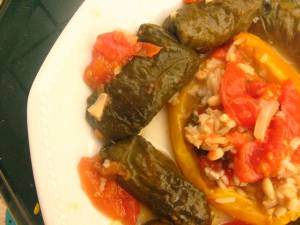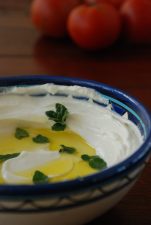 Edible wild plants are healthy vegetables that are free for the picking. Here are two of our favorites growing now in the Middle East, with recipes.
Edible wild plants are healthy vegetables that are free for the picking. Here are two of our favorites growing now in the Middle East, with recipes.
Our monthly seasonal produce posts always carry forager’s notes for those who follow the Middle Eastern tradition of eating wild greens. See our latest seasonal post with a list of many wild edibles. With this winter’s relatively abundant rains, wild edibles are growing out of every crack in the sidewalk and filling up neglected gardens and fields.
Take nettles. Take them carefully though, because they sting. A good way to harvest this assertive vegetable is to cut the stems with scissors, then still holding the stem with the scissors, drop it into your collecting bag. Handle the nettles with kitchen gloves to avoid getting stung once you get them into the kitchen. We’ve written about nettles before, and here’s a post with some different tips on cooking them.
 Why go through all that trouble? Well, nettles are amazingly high in iron, calcium and vitamin K, among other nutrients. And they taste good, especially cooked with rice. Nettle’s flavor is uniquely dark, a little reminiscent of dried seaweed.
Why go through all that trouble? Well, nettles are amazingly high in iron, calcium and vitamin K, among other nutrients. And they taste good, especially cooked with rice. Nettle’s flavor is uniquely dark, a little reminiscent of dried seaweed.
A delicious tonic soup: 2 cups chopped nettles, 1 medium onion, 1 chopped tomato, 1/2 cup raw rice and 2 cups water. Add a bay leaf, 2 cardomom pods, 1/2 teaspoon ground turmeric and salt and pepper to taste. Cook, covered, over medium heat till the rice is very soft – about 1/2 hour. Blend, and before serving, stir a little good butter or cream into the soup.
Collect nettles before their seeds have matured, while the leaves are broad and dark green. I dry them for eating year around, tying small bunches together and hanging them upside down till leaves and stems are dry and crisp.
Herb Drying Tips
When drying herbs, make small bunches so that air will circulate between the leaves, drying the individual leaves and stems entirely. Crowded into big bunches, parts will remain damp and go moldy.
 A nourishing overnight nettles infusion: 1 tsp. dried or fresh nettles per cup of boiling water, covered and allowed to stand 8 hours. This nourishes kidneys and raises your hemoglobin. Keep it covered while infusing and strain before drinking.
A nourishing overnight nettles infusion: 1 tsp. dried or fresh nettles per cup of boiling water, covered and allowed to stand 8 hours. This nourishes kidneys and raises your hemoglobin. Keep it covered while infusing and strain before drinking.
Velvety-soft mallow leaves are a springtime treat in the Middle East, usually stuffed as grape leaves are and presented in neat rolled-up little packages. Tramping around an abandoned lot in search of wild edibles, I recently saw a little old lady with the head kerchief and hennaed braid typical of old-fashioned Moroccan grandmothers.
She was bent over a particularly fine stand of mallows, carefully choosing the broadest, cleanest looking leaves, probably for stuffing. You can easily stuff mallows using our filling for stuffed Jerusalem sage.
 Maybe Middle Eastern grandmas have always known how good for you mallows are, being as rich in Vitamin C as oranges. They’re also full of a soothing demulcent property that’s good for the skin and the digestion. And they’re high in iron as well. I like to chop big leaves into ribbons and cook them the way I do spinach or Swiss chard. Or saute a good handful with onion and a little red bell pepper and stuff an omelet with them. Mallows are easy to handle. I dry them for future cooking also.
Maybe Middle Eastern grandmas have always known how good for you mallows are, being as rich in Vitamin C as oranges. They’re also full of a soothing demulcent property that’s good for the skin and the digestion. And they’re high in iron as well. I like to chop big leaves into ribbons and cook them the way I do spinach or Swiss chard. Or saute a good handful with onion and a little red bell pepper and stuff an omelet with them. Mallows are easy to handle. I dry them for future cooking also.
Here is a plateful of mallows I recently stuffed, along with an extra half bell pepper.
Small, tender mallow leaves fit into almost any salad. Their taste is almost neutral, just sort of green. Children have always loved picking the mature seed pods, called “cheeses” in English, for the crunch and for the fun of eating something wild. I throw a handful into my salads too. And finally, the lovely flowers make a soothing tea for coughs, and a good facial rinse for any skin type. Make according to the instructions for nettles tea, above.
 So go forth and walk the land. Your wild veggies are waiting for you.
So go forth and walk the land. Your wild veggies are waiting for you.
More vegewarian recipes and wild veggie talk:
All photos by Miriam Kresh.




Miriam, I am also observant and concerned with insects on vegetables. I suggest you don a pair of flexible kitchen gloves to deal with nettles, and inspect them as you would any other green leaf. When they’re fresh and strong they are seldom infested, but I wouldn’t assume nettles are insect-free.
As far as the sting, I’ve found over the years that it doesn’t bother me anymore. I do feel the sting, but it’s quite ignorable. These days I pick most of my nettles barehanded, unless they’re the big fierce purplish ones (not found in my neighborhood anyway). But then I’ve been picking nettles for over 20 years. Gloves and long sleeves are probably the solution for you.
Hi, I would like to cook with nettles, however as an orthodox Jew I always feel the need to check for insects… I get stung – and put off from continuing even to the cutting stage.
Can I assume nettles don’t have insects(why would the insect choose the stingy plant)?
Any tips on handling the leaves close up?
Thank you
Miriam
p.s – nettle leaves make a great salve as well – especially for nettle stings. They cure their own sting!